BUS-FP3062 - Time Value of Money: Single Cash Flow Assignment
VerifiedAdded on 2022/08/22
|8
|1142
|18
Homework Assignment
AI Summary
This assignment solution addresses the core concepts of the Time Value of Money (TVM) within the context of a Fundamentals of Finance course. The assignment begins by exploring the significance of cash flow in business value creation, emphasizing the importance of analyzing timing, uncertainty, and amounts for cash. It then defines and contrasts present value (PV) and future value (FV), explaining the discounting and capitalization processes, along with the variables that impact these values. The solution further delves into the inverse relationship between interest rates and present values, providing calculations for future values based on different interest rates and compounding periods. The assignment includes numerical problems involving present and future values and rates of return calculations. This assignment is a comprehensive guide for anyone studying the time value of money.
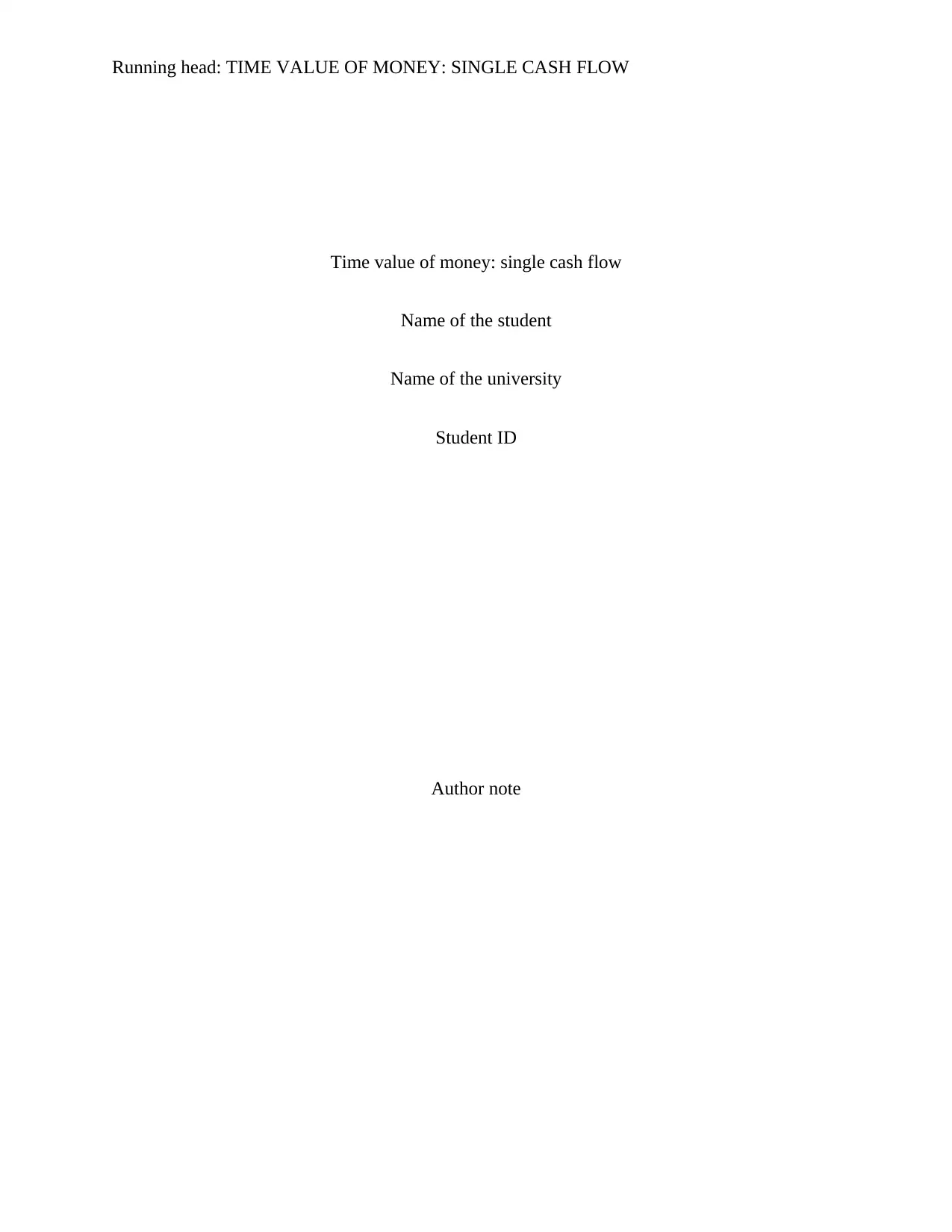
Running head: TIME VALUE OF MONEY: SINGLE CASH FLOW
Time value of money: single cash flow
Name of the student
Name of the university
Student ID
Author note
Time value of money: single cash flow
Name of the student
Name of the university
Student ID
Author note
Paraphrase This Document
Need a fresh take? Get an instant paraphrase of this document with our AI Paraphraser
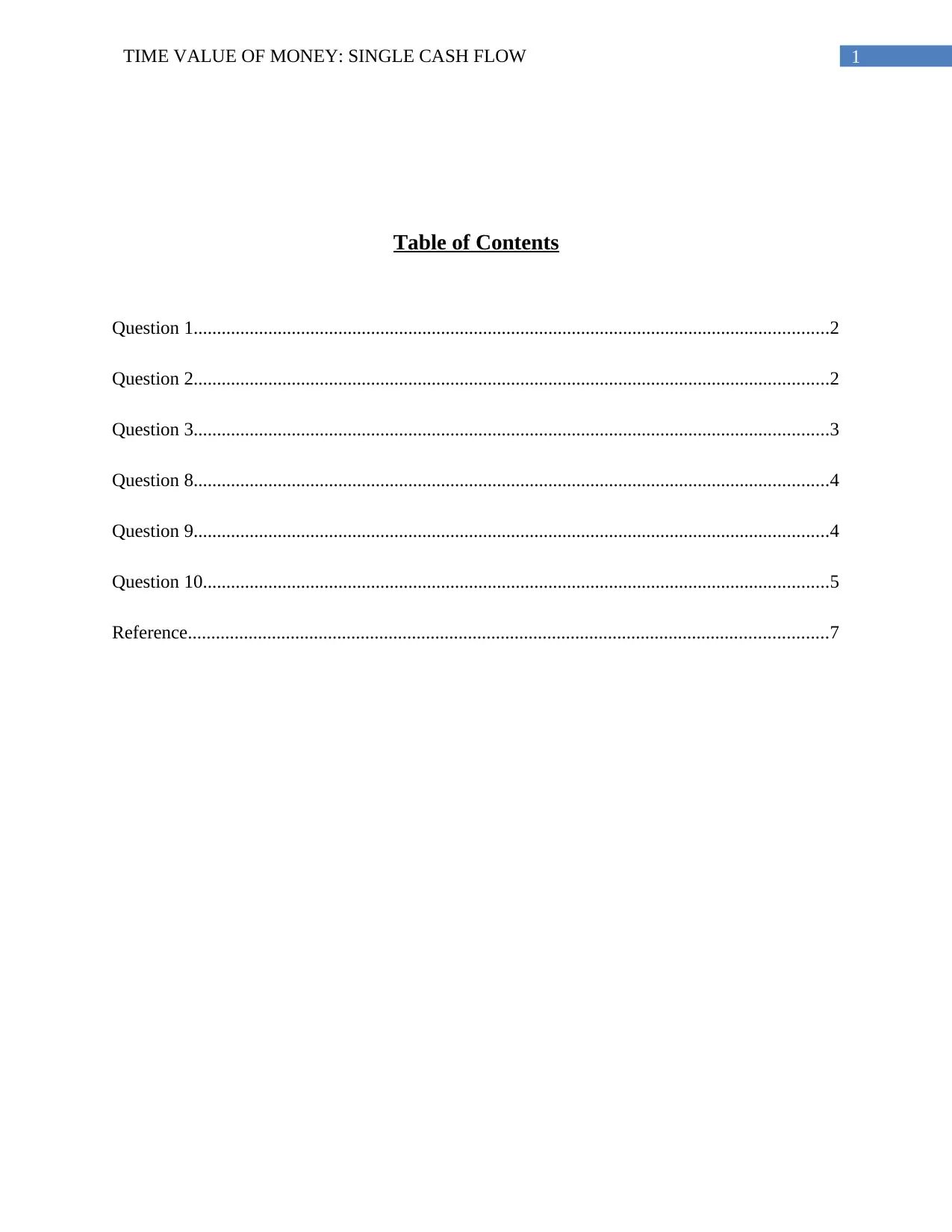
1TIME VALUE OF MONEY: SINGLE CASH FLOW
Table of Contents
Question 1........................................................................................................................................2
Question 2........................................................................................................................................2
Question 3........................................................................................................................................3
Question 8........................................................................................................................................4
Question 9........................................................................................................................................4
Question 10......................................................................................................................................5
Reference.........................................................................................................................................7
Table of Contents
Question 1........................................................................................................................................2
Question 2........................................................................................................................................2
Question 3........................................................................................................................................3
Question 8........................................................................................................................................4
Question 9........................................................................................................................................4
Question 10......................................................................................................................................5
Reference.........................................................................................................................................7
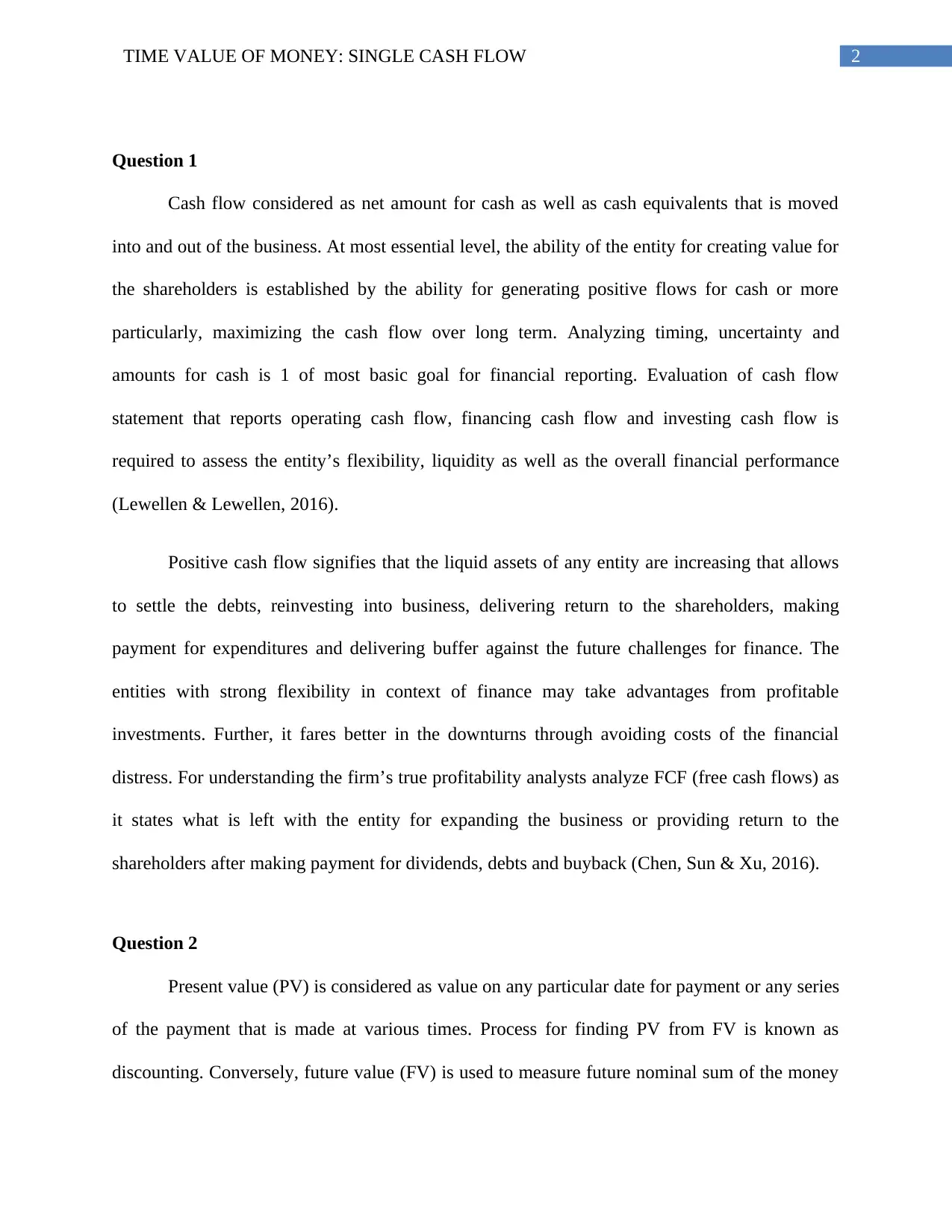
2TIME VALUE OF MONEY: SINGLE CASH FLOW
Question 1
Cash flow considered as net amount for cash as well as cash equivalents that is moved
into and out of the business. At most essential level, the ability of the entity for creating value for
the shareholders is established by the ability for generating positive flows for cash or more
particularly, maximizing the cash flow over long term. Analyzing timing, uncertainty and
amounts for cash is 1 of most basic goal for financial reporting. Evaluation of cash flow
statement that reports operating cash flow, financing cash flow and investing cash flow is
required to assess the entity’s flexibility, liquidity as well as the overall financial performance
(Lewellen & Lewellen, 2016).
Positive cash flow signifies that the liquid assets of any entity are increasing that allows
to settle the debts, reinvesting into business, delivering return to the shareholders, making
payment for expenditures and delivering buffer against the future challenges for finance. The
entities with strong flexibility in context of finance may take advantages from profitable
investments. Further, it fares better in the downturns through avoiding costs of the financial
distress. For understanding the firm’s true profitability analysts analyze FCF (free cash flows) as
it states what is left with the entity for expanding the business or providing return to the
shareholders after making payment for dividends, debts and buyback (Chen, Sun & Xu, 2016).
Question 2
Present value (PV) is considered as value on any particular date for payment or any series
of the payment that is made at various times. Process for finding PV from FV is known as
discounting. Conversely, future value (FV) is used to measure future nominal sum of the money
Question 1
Cash flow considered as net amount for cash as well as cash equivalents that is moved
into and out of the business. At most essential level, the ability of the entity for creating value for
the shareholders is established by the ability for generating positive flows for cash or more
particularly, maximizing the cash flow over long term. Analyzing timing, uncertainty and
amounts for cash is 1 of most basic goal for financial reporting. Evaluation of cash flow
statement that reports operating cash flow, financing cash flow and investing cash flow is
required to assess the entity’s flexibility, liquidity as well as the overall financial performance
(Lewellen & Lewellen, 2016).
Positive cash flow signifies that the liquid assets of any entity are increasing that allows
to settle the debts, reinvesting into business, delivering return to the shareholders, making
payment for expenditures and delivering buffer against the future challenges for finance. The
entities with strong flexibility in context of finance may take advantages from profitable
investments. Further, it fares better in the downturns through avoiding costs of the financial
distress. For understanding the firm’s true profitability analysts analyze FCF (free cash flows) as
it states what is left with the entity for expanding the business or providing return to the
shareholders after making payment for dividends, debts and buyback (Chen, Sun & Xu, 2016).
Question 2
Present value (PV) is considered as value on any particular date for payment or any series
of the payment that is made at various times. Process for finding PV from FV is known as
discounting. Conversely, future value (FV) is used to measure future nominal sum of the money
⊘ This is a preview!⊘
Do you want full access?
Subscribe today to unlock all pages.

Trusted by 1+ million students worldwide

3TIME VALUE OF MONEY: SINGLE CASH FLOW
that is provided by the allocated sum of money’s value at particular future time after making
assumption for specific interest rates or generally the return rate. FV is computed through
multiplying PV by accumulation function. Values are not inclusive of corrections for the
inflation or any other factors that has its impact on the true value of the money in future period.
Procedure for finding FV is generally called as capitalization (Balachandran & Faff, 2015).
FV and PV are related that reflects the compounding interest that is simple interest has
‘n’ multiplied by ‘i’ rather than as exponent. As this is really rare using simple interest the
formula is considered as important.
FV = PV (1 + i)n
FV and PV directly vary that is when one goes up other also goes up with the assumption
that rate for interest and number of the periods stay constant.
Rate of interest or rate of discount and sum of periods are 2 other variables that have its
impact on PV and FV. With higher rate of interest PV is lower and FV is higher. Same is
applicable for number of periods. With passing of more times or accrual of more interest per
period, FV becomes higher with constant PV (Leyman & Vanhoucke, 2016).
Question 3
PV equals the FV reduced by the interest generated from ownership. Here, the future
value is that amount at which present value will grow over specific period of the time. Rates of
interest have inverse relationship with present values. Increase in the expected rate of interest
leads to lower PV as FV are discounted at the high rate for becoming smaller (Krüger, Landier &
Thesmar, 2015).
that is provided by the allocated sum of money’s value at particular future time after making
assumption for specific interest rates or generally the return rate. FV is computed through
multiplying PV by accumulation function. Values are not inclusive of corrections for the
inflation or any other factors that has its impact on the true value of the money in future period.
Procedure for finding FV is generally called as capitalization (Balachandran & Faff, 2015).
FV and PV are related that reflects the compounding interest that is simple interest has
‘n’ multiplied by ‘i’ rather than as exponent. As this is really rare using simple interest the
formula is considered as important.
FV = PV (1 + i)n
FV and PV directly vary that is when one goes up other also goes up with the assumption
that rate for interest and number of the periods stay constant.
Rate of interest or rate of discount and sum of periods are 2 other variables that have its
impact on PV and FV. With higher rate of interest PV is lower and FV is higher. Same is
applicable for number of periods. With passing of more times or accrual of more interest per
period, FV becomes higher with constant PV (Leyman & Vanhoucke, 2016).
Question 3
PV equals the FV reduced by the interest generated from ownership. Here, the future
value is that amount at which present value will grow over specific period of the time. Rates of
interest have inverse relationship with present values. Increase in the expected rate of interest
leads to lower PV as FV are discounted at the high rate for becoming smaller (Krüger, Landier &
Thesmar, 2015).
Paraphrase This Document
Need a fresh take? Get an instant paraphrase of this document with our AI Paraphraser
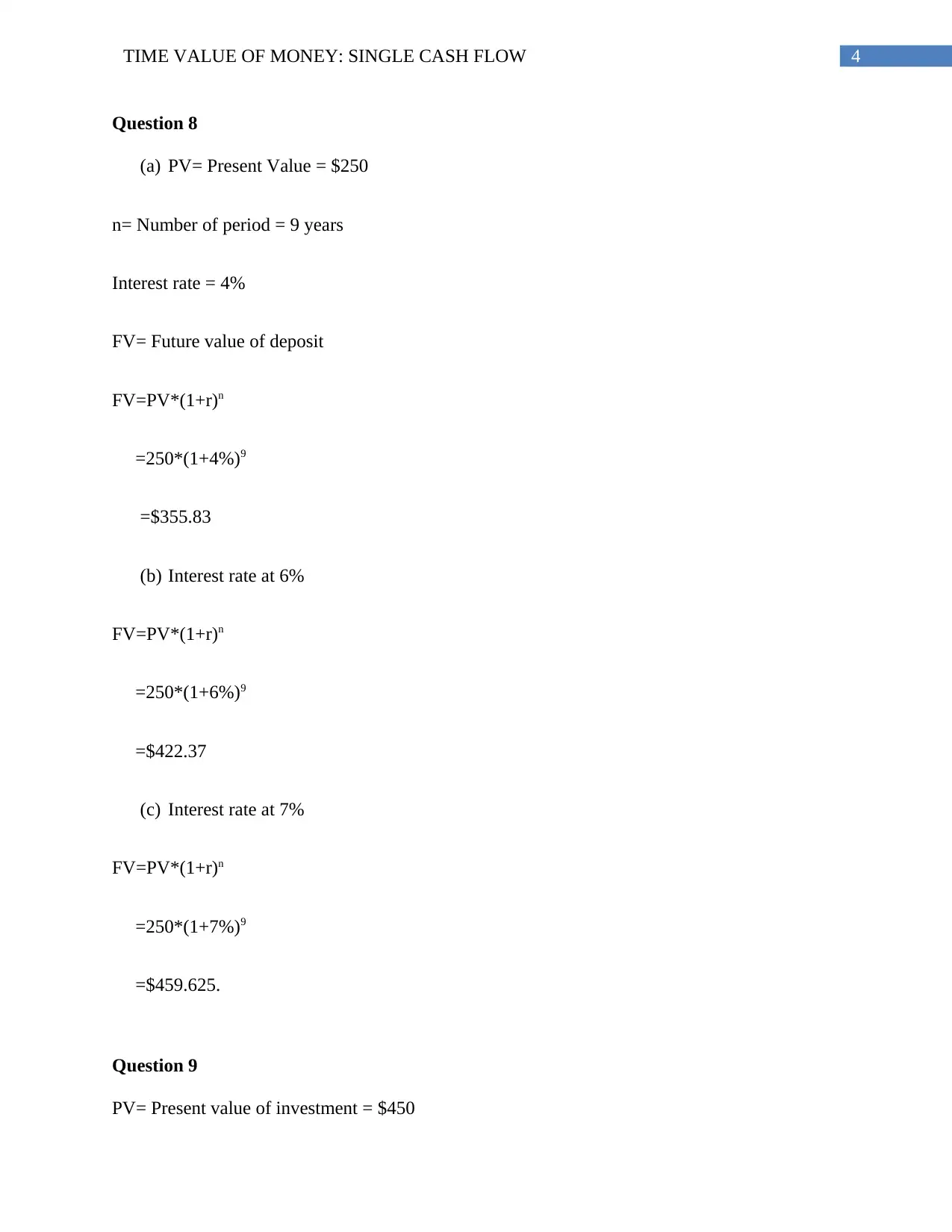
4TIME VALUE OF MONEY: SINGLE CASH FLOW
Question 8
(a) PV= Present Value = $250
n= Number of period = 9 years
Interest rate = 4%
FV= Future value of deposit
FV=PV*(1+r)n
=250*(1+4%)9
=$355.83
(b) Interest rate at 6%
FV=PV*(1+r)n
=250*(1+6%)9
=$422.37
(c) Interest rate at 7%
FV=PV*(1+r)n
=250*(1+7%)9
=$459.625.
Question 9
PV= Present value of investment = $450
Question 8
(a) PV= Present Value = $250
n= Number of period = 9 years
Interest rate = 4%
FV= Future value of deposit
FV=PV*(1+r)n
=250*(1+4%)9
=$355.83
(b) Interest rate at 6%
FV=PV*(1+r)n
=250*(1+6%)9
=$422.37
(c) Interest rate at 7%
FV=PV*(1+r)n
=250*(1+7%)9
=$459.625.
Question 9
PV= Present value of investment = $450

5TIME VALUE OF MONEY: SINGLE CASH FLOW
r1= 6% Interest rate in year 1
r2= 3% Interest rate in year 2
r3 = 7% Interest rate in year 3
FV= Future value of Deposit
FV= PV*(1+r1)*(1+r2)*(1+r3)
=450*(1+6%)*(1+3%)*(1+7%) = $525.70
Question 10
PV= Present value of deposit=$8000
n= Number of periods=5
FV=Future value of investment
r = Rate of return
(a)r =(FV/PV)(1/n)-1
=(12500/8000)(1/5)-1
= 9.34%
b)Growth in 6 years
n= number of period=6
r =(FV/PV)(1/n)-1
r1= 6% Interest rate in year 1
r2= 3% Interest rate in year 2
r3 = 7% Interest rate in year 3
FV= Future value of Deposit
FV= PV*(1+r1)*(1+r2)*(1+r3)
=450*(1+6%)*(1+3%)*(1+7%) = $525.70
Question 10
PV= Present value of deposit=$8000
n= Number of periods=5
FV=Future value of investment
r = Rate of return
(a)r =(FV/PV)(1/n)-1
=(12500/8000)(1/5)-1
= 9.34%
b)Growth in 6 years
n= number of period=6
r =(FV/PV)(1/n)-1
⊘ This is a preview!⊘
Do you want full access?
Subscribe today to unlock all pages.

Trusted by 1+ million students worldwide

6TIME VALUE OF MONEY: SINGLE CASH FLOW
=(12500/8000)(1/6)-1
=7.72%
c) Growth in 8 years
n= number of periods=8
r = (FV/PV)(1/n)-1
= (12500/8000)(1/8)-1
=5.74%
=(12500/8000)(1/6)-1
=7.72%
c) Growth in 8 years
n= number of periods=8
r = (FV/PV)(1/n)-1
= (12500/8000)(1/8)-1
=5.74%
Paraphrase This Document
Need a fresh take? Get an instant paraphrase of this document with our AI Paraphraser
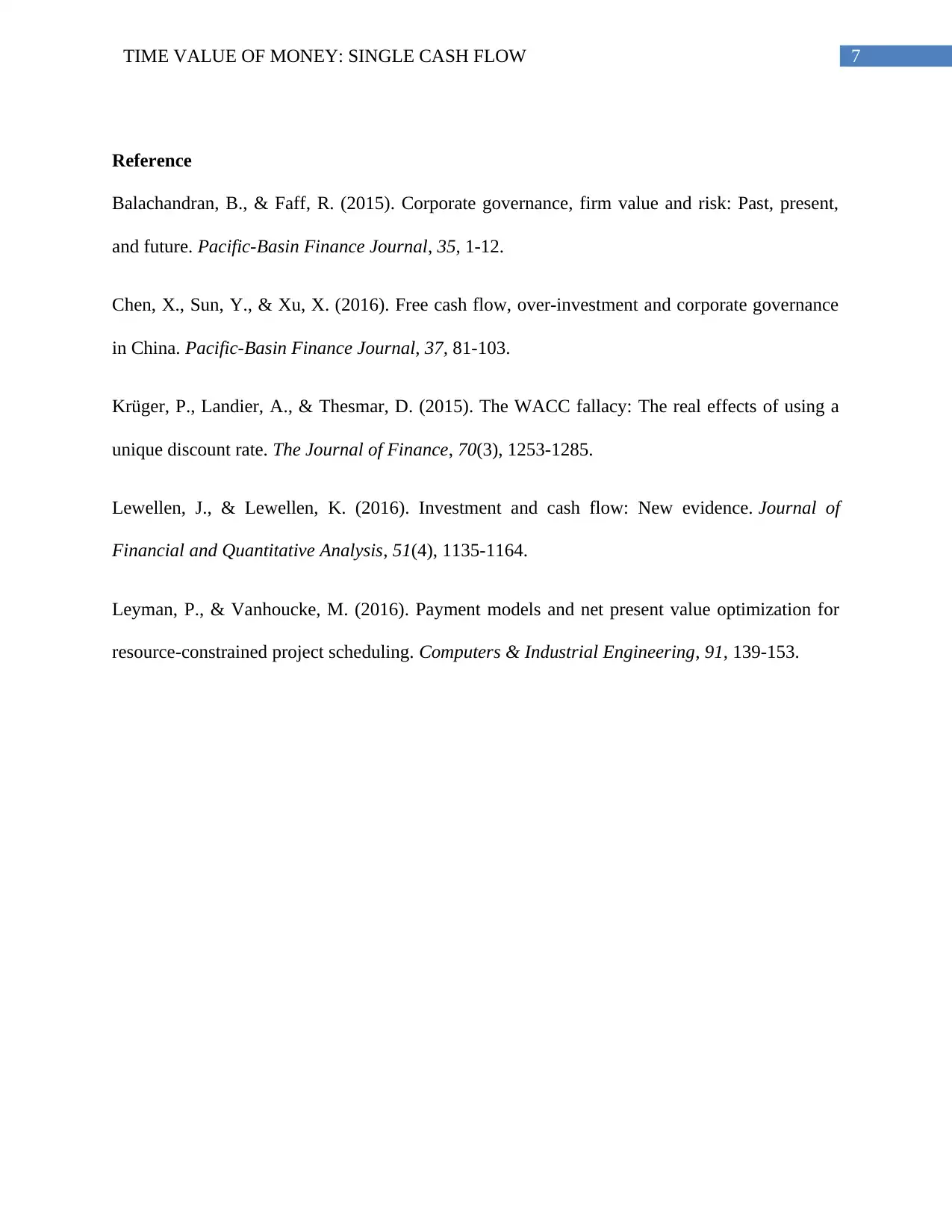
7TIME VALUE OF MONEY: SINGLE CASH FLOW
Reference
Balachandran, B., & Faff, R. (2015). Corporate governance, firm value and risk: Past, present,
and future. Pacific-Basin Finance Journal, 35, 1-12.
Chen, X., Sun, Y., & Xu, X. (2016). Free cash flow, over-investment and corporate governance
in China. Pacific-Basin Finance Journal, 37, 81-103.
Krüger, P., Landier, A., & Thesmar, D. (2015). The WACC fallacy: The real effects of using a
unique discount rate. The Journal of Finance, 70(3), 1253-1285.
Lewellen, J., & Lewellen, K. (2016). Investment and cash flow: New evidence. Journal of
Financial and Quantitative Analysis, 51(4), 1135-1164.
Leyman, P., & Vanhoucke, M. (2016). Payment models and net present value optimization for
resource-constrained project scheduling. Computers & Industrial Engineering, 91, 139-153.
Reference
Balachandran, B., & Faff, R. (2015). Corporate governance, firm value and risk: Past, present,
and future. Pacific-Basin Finance Journal, 35, 1-12.
Chen, X., Sun, Y., & Xu, X. (2016). Free cash flow, over-investment and corporate governance
in China. Pacific-Basin Finance Journal, 37, 81-103.
Krüger, P., Landier, A., & Thesmar, D. (2015). The WACC fallacy: The real effects of using a
unique discount rate. The Journal of Finance, 70(3), 1253-1285.
Lewellen, J., & Lewellen, K. (2016). Investment and cash flow: New evidence. Journal of
Financial and Quantitative Analysis, 51(4), 1135-1164.
Leyman, P., & Vanhoucke, M. (2016). Payment models and net present value optimization for
resource-constrained project scheduling. Computers & Industrial Engineering, 91, 139-153.
1 out of 8
Related Documents
Your All-in-One AI-Powered Toolkit for Academic Success.
+13062052269
info@desklib.com
Available 24*7 on WhatsApp / Email
![[object Object]](/_next/static/media/star-bottom.7253800d.svg)
Unlock your academic potential
Copyright © 2020–2025 A2Z Services. All Rights Reserved. Developed and managed by ZUCOL.





